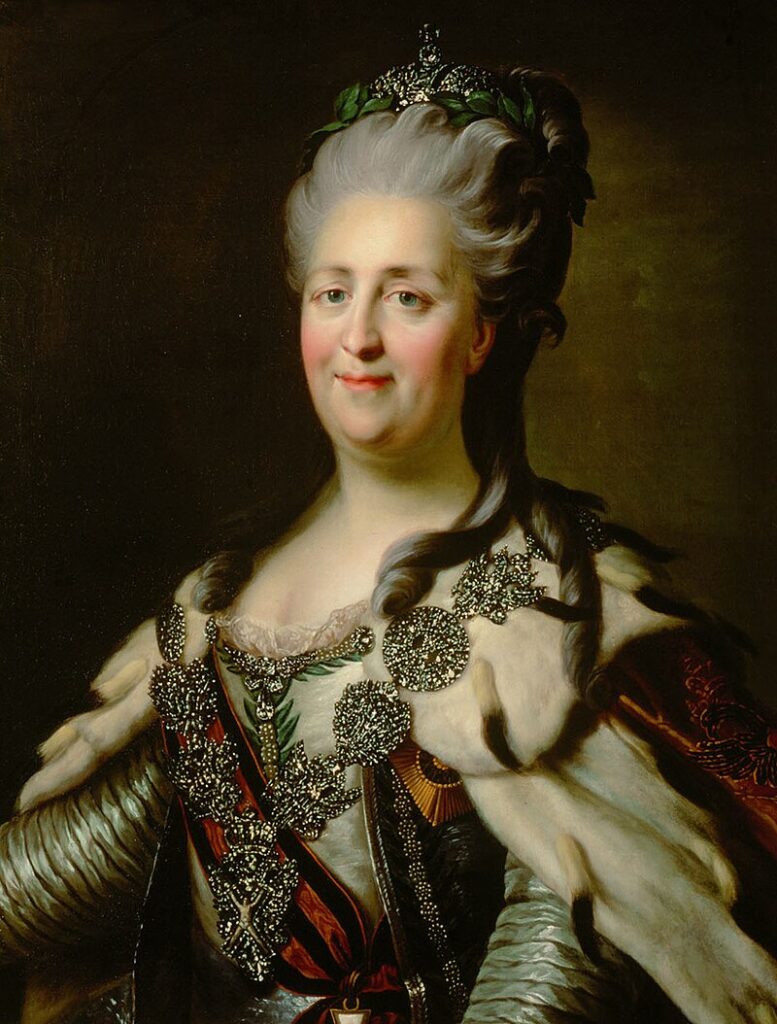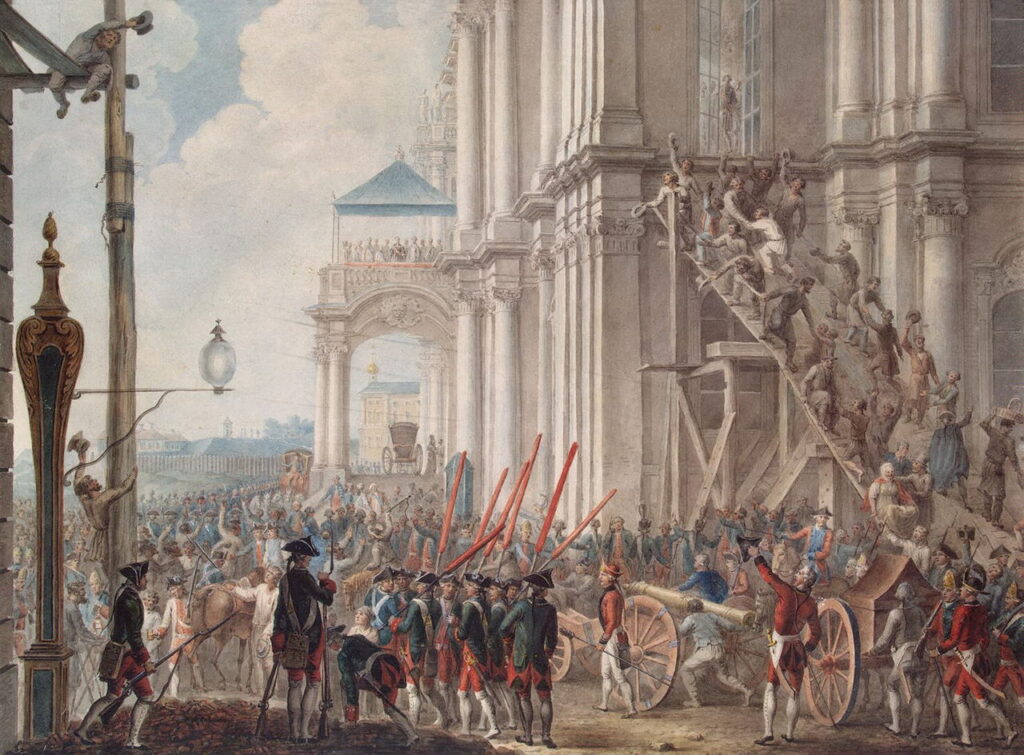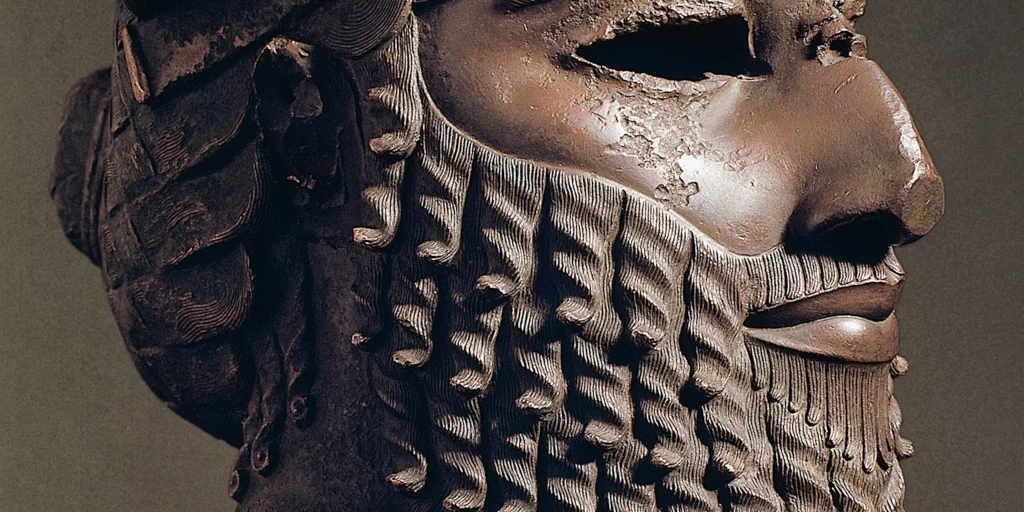Catherine the Great is one of the most iconic female rulers in history. Although her name is known throughout the world, most people don’t know why she is famous. Catherine the Great was one of many female empresses of Russia.
During her reign she significantly expanded Russia’s borders, encouraged cultural reforms, and proved herself a formidable political opponent, specifically to her husband, Peter III.
Yet, beneath the crown of historical achievements lies a searing question that has sparked debates among historians for centuries: Did Catherine the Great kill her husband, Peter III?

Catherine the Great: Becoming Catherine
Catherine the Great was born on May 2, 1729, in Stettin, Prussia, which is now Szczecin, Poland. She was born with the name Sophie Friederike Auguste von Anhalt-Zerbst to the Prince of Anhalt-Zerbst, Christian August, and his wife, Princess Johanna Elisabeth of Holstein-Gottorp.
Her father was a small-time German prince but her mother was connected to the more higher-ups in the German and Scandinavian royal families.
Family Background and Education
Despite her royal parents, Sophie’s family was very modest compared to the other royals. She didn’t attend a formal school but was instead taught privately by an army of tutors who taught her German, French, and Russian as well as royal etiquette.
Her mother, Johanna Elisabeth knew that these were essential assets to have if you wanted to attract the attention of a prince. In fact, her mother went to great lengths to make sure her children were set for life. At the time, that meant marrying into wealthy and powerful families.
Path to the Russian Throne
Sophie’s connection to the Russian royal family came through her mother’s connections. Johanna Elisabeth’s sister was married to the Duke of Holstein-Gottorp, whose sister, Anna Petrovna, had married into the Russian royal family.
Through this channel, Elisabeth managed to arrange the marriage between her daughter and the future Peter III.
Early Life and Marriage to Peter III
When she arrived in Russia she converted to Eastern Orthodoxy and adopted the name Catherine. Her marriage to Peter III was intended to solidify her position, but it soon became clear that the match was not made in heaven.
Their personalities clashed almost immediately; Catherine was ambitious, intelligent, and politically savvy, while Peter acted immature, eccentric, and indifferent to Russian customs.
Peter III’s brief reign was characterized by radical reforms that often clashed with the sentiments of his subjects and the established Russian institutions.
His efforts to modernize the Russian military and his overt admiration for his hero Frederick II of Prussia, Russia’s adversary during the Seven Years’ War, greatly angered the Russian military and nobility.
Fanning the flames, his decision to end the war against Prussia and pull out Russian troops was seen as treason and eroded his support further. His move to secularize church lands provoked the ire of the Russian Orthodox Church and its followers.
In contrast, Catherine was deeply integrated into Russian society and politics. She was loved by the public and had cultivated strong relationships with the Russian nobility and the great thinkers of the time.
She attempted to strengthen Russia’s position as a major European power while carefully sprinkling in Enlightenment ideas to avoid alienating the ruling classes. Catherine’s alignment with Russian cultural values and her strategic approach to reform garnered her widespread support among the common people.
Ascension to Power
As Peter III’s inadequacies became more of a liability, Catherine gathered the support of key political and military leaders. Her deep understanding of Russian politics and her ability to connect with the Russian elite and commoners alike strengthened her position. In contrast, Peter’s controversial decisions, including his overt disdain for Russian traditions and his unpopular foreign policy choices, alienated many of his constituents.
The Overthrow of Peter III
The seeds for the coup against Peter III were sown through a combination of his own unpopular policies and Catherine’s rising influence within the Russian court and among the military.
Catherine, unlike Peter, had taken the time to build relationships with key figures in the Russian political landscape, including the influential Guards regiments stationed around St. Petersburg.
As the public’s dissatisfaction with Peter’s reign grew, particularly his perceived betrayal of Russian interests and his alienation from the church and military, Catherine’s position strengthened. She presented herself as a defender of Russian traditions and Orthodox faith, contrasting sharply with Peter’s erratic, un-Russian behavior.

Details of the Coup
The actual coup was quick and relatively bloodless, occurring in July 1762. It was orchestrated by a group of high-ranking officers and court officials who were disillusioned with Peter’s reign and supportive of Catherine. The conspirators declared Catherine the sole ruler of Russia in a bold move that capitalized on the widespread unrest among the nobility and military.
Peter was arrested without any significant resistance, as many of his supposed supporters quickly shifted their allegiance to Catherine. The ease with which the coup was executed reflected Peter’s lack of support and Catherine’s careful and methodical preparation.
Immediate Aftermath
Following the coup, Peter III was forced to abdicate, and he was detained under guard in Ropsha, a small estate outside of St. Petersburg. His reign had lasted just six months. Shortly after his abdication, Peter III died under mysterious circumstances.
Official reports claimed that his death was due to a severe illness, but rumors of assassination swirled, suggesting that he might have been murdered to prevent any attempt to reclaim the throne.
The aftermath of the coup solidified Catherine’s power but also cast a long shadow over her reign. The manner of Peter’s removal and subsequent death raised questions about the legitimacy and morality of her rise to power.
Despite these controversies, Catherine moved swiftly to consolidate her authority, implementing reforms and securing her position by building on the loyalty of her supporters.
Theories About Peter III’s Death
The death of Peter III remains one of the most intriguing and disputed events in Russian history. Officially, he died of an illness, but many theories suggest foul play, contributing to the mystique and controversy surrounding Catherine the Great’s rise to power.
The Official Version of Events
According to the official narrative released at the time, Peter III died from a severe hemorrhoidal colic complicated by an apoplectic stroke. This account, however, has been met with skepticism by many historians and contemporaries alike, given the politically charged atmosphere following his abdication and the convenient timing of his death for Catherine’s consolidation of power.
Alternative Theories and Rumors
Over the centuries, several alternative theories about Peter III’s death have circulated, reflecting the deep divisions and suspicions of the time:
Assassination by Catherine’s Supporters: The most popular theory suggests that Peter was assassinated at the behest of Catherine or her close allies to secure her position on the throne and eliminate any possibility of his return to power. This theory is supported by accounts from some contemporary observers and later historians who believe that the coup plotters would not have left such a loose end untied.
Murder by Individual Initiative: Another theory posits that although Catherine might not have directly ordered Peter’s assassination, it was carried out by zealous supporters who believed that eliminating Peter would be seen as a favor to their new empress and solidify her rule.
Natural Causes Exacerbated by Stress: A less dramatic but still widely discussed theory is that Peter could indeed have died from illness, which was exacerbated by the stress of his imprisonment and the dramatic loss of his throne and status.
Historical Evidence Supporting Different Theories
The difficulty in establishing the true cause of Peter III’s death lies in the lack of reliable contemporary evidence and the politically motivated distortions that influenced most accounts of the event:
Autopsy Reports: No autopsy report was publicly disclosed or verified, leaving the medical cause of Peter’s death uncertain and open to speculation.
Witness Testimonies: Accounts from guards and servants at Ropsha, where Peter was held, are contradictory and influenced by later political developments. Some claimed to have heard sounds of a struggle, while others maintained that Peter died alone in his room.
Modern Historical Analysis: Modern historians remain divided. Some argue that the lack of direct documentary evidence linking Catherine to the murder suggests that Peter’s death might indeed have been natural or accidental. Others point to the secretive and urgent manner in which Peter’s body was buried without public ceremony as indicative of foul play.

